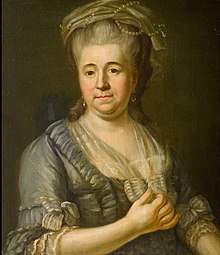Eleonore von Grothaus
Eleonore von Grothaus, also Eleonore von Münster[1] (10 April 1734 – 26 March 1794), was a German noblewoman, a writer and poet, and a lay musician. She may have assembled a collection of writings and music, the Ledenburg Collection from the manor house where she was born. The collection held music by notable 18th-century composers that seemed lost until it was rediscovered in 2015.
Eleonore von Grothaus | |
|---|---|
 Portrait of Eleonore Freiin von Münster zur Surenburg, née von Grothaus zur Ledenburg, c. 1770 | |
| Born | Eleonore Elisabeth Helene Sophie von Grothaus 10 April 1734 |
| Died | 26 March 1794 (aged 59) |
| Other names | Eleonore von Münster |
| Occupation | Writer and poet |
| Known for | Ledenburg Collection |
| Spouse(s) | Georg von Münster zu Surenburg |
| Children | Ernst zu Münster |
Life

Born in Schloss Ledenburg, Lower Saxony, Eleonore Elisabeth Helene Sophie von Grothaus[1][2] was the eldest daughter of the general Ernst Philipp von Grothaus, who served Hanover and the Kingdom of Great Britain, and his wife Anna Friederike von Oldershausen, who inherited considerable properties.[3] She grew up in the manor house.[2] She wrote poems, and was interested in art and the sciences.[2] Walter Schwarze, who published her biography in 1928, wrote:
"Among the rhetorical arts ... music took the first place, and much handwritten music for piano, viola d'amour[lower-alpha 1], flute and voice was in her repertoire, which was crowned by Handel and Telemann. The newest arias could be heard, and Eleonore wrote many a poem in this format or following existing melodies, and she expressed the impact of the music when she narrated how Orpheus sang ..."[2]
In 1759, she married Georg von Münster zu Surenburg (1721–1773), Hofmarschall of the Prince-Bishopric of Osnabrück. He was a widower with seven children.[4] The couple had six more children, including a son, Count Ernst Friedrich Herbert zu Münster-Ledenburg, Freiherr von Grothaus.[4] After her husband died in 1773, she devoted her time mostly to raising the children.[4] In 1783, she was appointed by Charles William Ferdinand, Duke of Brunswick-Wolfenbüttel to educate his daughter Caroline, then age 14, the future wife of George IV.[4] It was a difficult task, as she noted in her diaries.[4] She returned to Osnabrück in 1791 for a short time, and moved then to Hanover where she died. She is buried on the Gartenfriedhof.[4]
Work
Von Grothaus wrote around sixty poems, three stories and three stage works. She exchanged letters, for example with Justus Möser. She left two booklets with prose stories, two with diary entries from 1789 to 1790, and some poetry and prose in French.[5] She published several of her literary works under her married name, Eleonore von Münster.[6]
She may have been the collector of music, especially for the viola da gamba, which belonged to Schloss Ledenburg and is now in the State Archive of Lower Saxony, where it was studied from 2015, called the Ledenburg Collection, and mostly published by Edition Güntersberg.[2]
Notes
- Schwarze probably meant: viola da gamba, not viola d'amore
References
- Schwarze, Walter (1929). Eleonore von Münster : Eine unbekannte Dichterin aus der Zeit Mösers. Osnabrück.
- Zadow, Günter von (2016). "The Works for Viola da Gamba in the Ledenburg Collection" (PDF). The Viola da Gamba Society Journal. 10: 43–80 (especially 58–59). Retrieved 17 August 2017.
- Belehnungsurkunde from King Frederick William II of Prussia
- "Eleonore von Münster / geb. von Grothaus" (PDF) (in German). Gartenfriedhof Hannover. August 2015. Retrieved 18 August 2017.
- Eleonore v. Grothaus greathouse.us
- Neue Deutsche Biographie, Band 18, Berlin 1997, p. 533